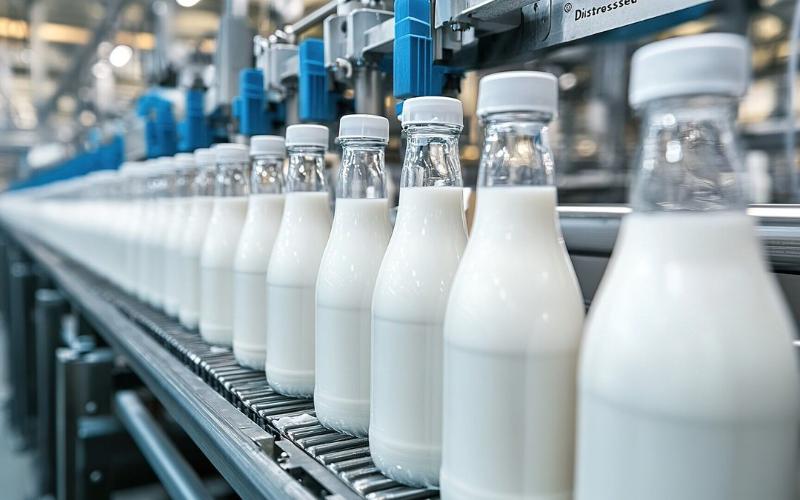Artificial insemination of cows will increase dairy and meat productivity - KazNAU scientists
Sourse: apk-news.kz
Artificial insemination of cows leads to an improvement in the genetic potential, which means high milk and meat productivity, scientists of Kazakhstan reported. This method is not fully used in the country, mainly by large commodity farms. Scientists say that artificial insemination technologies for breeding stock need to be introduced in the private sector.

"The criterion of the level of development of animal husbandry in any country, including dairy and beef cattle breeding, is the proportion of breeding stock. In developed countries, the percentage of breeding cattle reaches up to 65-70%. However, in the Republic of Kazakhstan, such an affordable way to improve the genetic potential of animals, increase productivity, as the method of artificial insemination of cows is not fully used. This method mainly covers large commercial dairy and partially breeding meat farms in our country. We believe that the introduction of artificial insemination technology for breeding stock of the private sector is an affordable tool to increase livestock productivity, increase genetic potential," said Professor of the Kazakh National Agrarian Research University Ye. Usenbekov.
The scientist named the reasons for the low level of use of artificial insemination technology for cows. According to him, this is a shortage of insemination technicians, the lack of appropriate government programs, the presence of opposing opinions about the low economic efficiency of using the method of artificial insemination of cows and heifers of the private sector, small and medium-sized farms.
"It should be noted that in the Republic of Kazakhstan, the number of cattle currently stands at about 8.5 million heads, of which 80-85% are concentrated in individual entrepreneurs, farms and owners of personal subsidiary farms. More than 55% of the cattle population is concentrated in households. The introduction of a method of artificial insemination of cows and heifers of the private sector is the most urgent problem in our country," the information says.
In 2023, financial resources were allocated in Zhambyl region for the introduction of artificial insemination technology for cows and heifers for owners of private farms. The work on artificial insemination of cows in the private sector was carried out between May 7 and November 30, 2023. In order to implement the project, 5 mobile groups for artificial insemination of cows were formed from among the staff of the Kazakh National Agar Research University and 20 insemination technicians from Zhambyl region were also included in the mobile groups.
A specialized car was attracted for the transportation of liquid nitrogen, liquid nitrogen was purchased at the Kazphosphate LLP plant at a price of 329 tenge per 1 kg.
It was planned to carry out artificial insemination of cows of the private sector of the Zhambyl region in 10 districts in 24 settlements in the amount of 5,127 heads, but 3,639 cows were actually inseminated.
"For artificial insemination of cows, depending on the demand of residents of different districts of the Zhambyl region, sperm from breeding bulls-producers of combined dairy and meat productivity were used: Simmental breed, Alatau breed, brown Swiss breed, dairy productivity, Holstein breed of Canadian breeding, local Aulieatin breed, meat productivity, domestic Kazakh white-headed breed, the local Auliekol breed, the Angus breed of American breeding," the scientist said.
The analysis showed that artificial insemination of cows in the private sector has its own characteristics: preliminary explanatory work among the population, ensuring the isolated maintenance of bulls of producers and mongrel bulls during artificial insemination, coordinated work with stockmen (to identify cows in hunting), uninterrupted provision of insemination technicians with liquid nitrogen, taking into account the natural and climatic characteristics of each the district, the correct selection of breeding bulls for insemination of breeding stock, the use of sperm from bulls of Holstein and Simmental breeds (in order to avoid large fertility), only for cows with a live weight of more than 320 kg.
"The start of the project was scheduled for April 15, 2023, however, due to the late deadline for the end of the competition and in connection with the purchase of Dewar vessels, defrosters, catheters, consumables, frozen sperm, work on artificial insemination began later - from May 11, 2023," the scientist said.
Currently, cows are calving in Zhualy district, rural district "Zhetitobe", settlements "Karikorgan and Konyrtobe", calves from a bull of the Simmental breed are received, calves from bulls of Holstein and Simmental breeds are received in Baizakovsky district, rural district "Tuymekent", in Kordai district, rural district "Kenen Azerbayev" calves were obtained from a bull of the Alatau breed, in the Talas district, rural district "Oyyk" from a bull of the Auliekol breed.
"The most effective advertisement is to obtain offspring by artificial insemination from breeding bulls. Residents of these districts express their gratitude to the scientists of KazNAIU for the work done," the scientist said.
The experience of the project shows that the key points are the availability of insemination technicians in settlements (there was a shortage of insemination technicians), low qualification of technicians - inseminators, artificial insemination of cows at the optimal time (March-May), logistical difficulties (monthly refueling of Dewar vessels), purchase of consumables through the public procurement procedure (takes a lot of time), during the artificial insemination of cows, ensuring the isolated maintenance of bulls and mongrel bulls (also a serious problem), the active position of rural akimats on the introduction of artificial insemination (in some localities, explanatory work was practically not carried out).
"Thus, the effectiveness of the introduction of artificial insemination technology depends on multiple factors. We recommend the preparation of a regional breeding program for the genetic improvement of livestock in the private sector, livestock of small and medium-sized farms, the training of insemination technicians, and awareness-raising among the population. The minimum time frame for the implementation of the artificial insemination project should be 5-6 years, only then can real results be obtained to improve livestock productivity," the information says. Usenbekov.
The scientist named the reasons for the low level of use of artificial insemination technology for cows. According to him, this is a shortage of insemination technicians, the lack of appropriate government programs, the presence of opposing opinions about the low economic efficiency of using the method of artificial insemination of cows and heifers of the private sector, small and medium-sized farms.
"It should be noted that in the Republic of Kazakhstan, the number of cattle currently stands at about 8.5 million heads, of which 80-85% are concentrated in individual entrepreneurs, farms and owners of personal subsidiary farms. More than 55% of the cattle population is concentrated in households. The introduction of a method of artificial insemination of cows and heifers of the private sector is the most urgent problem in our country," the information says.
In 2023, financial resources were allocated in Zhambyl region for the introduction of artificial insemination technology for cows and heifers for owners of private farms. The work on artificial insemination of cows in the private sector was carried out between May 7 and November 30, 2023. In order to implement the project, 5 mobile groups for artificial insemination of cows were formed from among the staff of the Kazakh National Agar Research University and 20 insemination technicians from Zhambyl region were also included in the mobile groups.
A specialized car was attracted for the transportation of liquid nitrogen, liquid nitrogen was purchased at the Kazphosphate LLP plant at a price of 329 tenge per 1 kg.
It was planned to carry out artificial insemination of cows of the private sector of the Zhambyl region in 10 districts in 24 settlements in the amount of 5,127 heads, but 3,639 cows were actually inseminated.
"For artificial insemination of cows, depending on the demand of residents of different districts of the Zhambyl region, sperm from breeding bulls-producers of combined dairy and meat productivity were used: Simmental breed, Alatau breed, brown Swiss breed, dairy productivity, Holstein breed of Canadian breeding, local Aulieatin breed, meat productivity, domestic Kazakh white-headed breed, the local Auliekol breed, the Angus breed of American breeding," the scientist said.
The analysis showed that artificial insemination of cows in the private sector has its own characteristics: preliminary explanatory work among the population, ensuring the isolated maintenance of bulls of producers and mongrel bulls during artificial insemination, coordinated work with stockmen (to identify cows in hunting), uninterrupted provision of insemination technicians with liquid nitrogen, taking into account the natural and climatic characteristics of each the district, the correct selection of breeding bulls for insemination of breeding stock, the use of sperm from bulls of Holstein and Simmental breeds (in order to avoid large fertility), only for cows with a live weight of more than 320 kg.
"The start of the project was scheduled for April 15, 2023, however, due to the late deadline for the end of the competition and in connection with the purchase of Dewar vessels, defrosters, catheters, consumables, frozen sperm, work on artificial insemination began later - from May 11, 2023," the scientist said.
Currently, cows are calving in Zhualy district, rural district "Zhetitobe", settlements "Karikorgan and Konyrtobe", calves from a bull of the Simmental breed are received, calves from bulls of Holstein and Simmental breeds are received in Baizakovsky district, rural district "Tuymekent", in Kordai district, rural district "Kenen Azerbayev" calves were obtained from a bull of the Alatau breed, in the Talas district, rural district "Oyyk" from a bull of the Auliekol breed.
"The most effective advertisement is to obtain offspring by artificial insemination from breeding bulls. Residents of these districts express their gratitude to the scientists of KazNAIU for the work done," the scientist said.
The experience of the project shows that the key points are the availability of insemination technicians in settlements (there was a shortage of insemination technicians), low qualification of technicians - inseminators, artificial insemination of cows at the optimal time (March-May), logistical difficulties (monthly refueling of Dewar vessels), purchase of consumables through the public procurement procedure (takes a lot of time), during the artificial insemination of cows, ensuring the isolated maintenance of bulls and mongrel bulls (also a serious problem), the active position of rural akimats on the introduction of artificial insemination (in some localities, explanatory work was practically not carried out).
"Thus, the effectiveness of the introduction of artificial insemination technology depends on multiple factors. We recommend the preparation of a regional breeding program for the genetic improvement of livestock in the private sector, livestock of small and medium-sized farms, the training of insemination technicians, and awareness-raising among the population. The minimum time frame for the implementation of the artificial insemination project should be 5-6 years, only then can real results be obtained to improve livestock productivity," the information says. Usenbekov.












